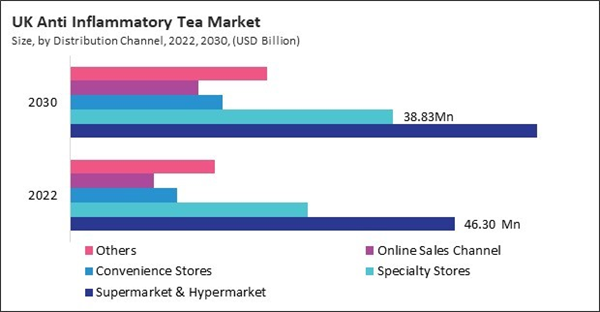The Europe Anti Inflammatory Tea Market would witness market growth of 4.7% CAGR during the forecast period (2023-2030). In the year 2020, the Europe market's volume surged to 2,511.73 tonnes, showcasing a growth of 4.3% (2019-2022).
Sales of anti-inflammatory tea in supermarkets and hypermarkets have experienced steady growth in recent years, reflecting increasing consumer awareness of the health benefits associated with these products. Supermarkets and hypermarkets offer a convenient one-stop shopping experience for consumers. Thus, the UK market consumed 617.40 tonnes of anti-inflammatory tea in the market 2022.
The Germany market dominated the Europe Anti Inflammatory Tea Market by Country in 2022, and would continue to be a dominant market till 2030; thereby, achieving a market value of $175.3 million by 2030. The UK market is exhibiting a CAGR of 3.7% during (2023 - 2030). Additionally, The France market would experience a CAGR of 5.4% during (2023 - 2030).
Individuals managing chronic inflammatory conditions such as arthritis, autoimmune disorders, and inflammatory bowel disease often turn to anti-inflammatory teas as complementary therapies to alleviate symptoms and improve quality of life.
Moreover, consumers may use this alongside conventional treatments to manage inflammation and reduce reliance on pharmaceutical interventions. Also, the aging population is increasingly seeking natural remedies to support healthy aging and mitigate age-related inflammation.
The impact of growing chronic disease in Europe on market is substantial, driving increased demand, expanding the consumer base, and creating opportunities for innovation and market growth. As individuals increasingly seek natural and holistic approaches to managing chronic health conditions, these are poised to significantly promote health and well-being across the region. Hence, the region’s increasing burden of chronic diseases is propelling the market’s growth.
Based on Packaging, the market is segmented into Tea Bags, Paperboards, Loose Tea, and Aluminium Tins. Based on Distribution Channel, the market is segmented into Supermarket & Hypermarket, Specialty Stores, Convenience Stores, Online Sales Channel, and Others. Based on Type, the market is segmented into Black Tea, Green Tea, Ginger, Cinnamon, Turmeric, Chamomile, Peppermint, and Lemongrass. Based on countries, the market is segmented into Germany, UK, France, Russia, Spain, Italy, and Rest of Europe.
Sales of anti-inflammatory tea in supermarkets and hypermarkets have experienced steady growth in recent years, reflecting increasing consumer awareness of the health benefits associated with these products. Supermarkets and hypermarkets offer a convenient one-stop shopping experience for consumers. Thus, the UK market consumed 617.40 tonnes of anti-inflammatory tea in the market 2022.
The Germany market dominated the Europe Anti Inflammatory Tea Market by Country in 2022, and would continue to be a dominant market till 2030; thereby, achieving a market value of $175.3 million by 2030. The UK market is exhibiting a CAGR of 3.7% during (2023 - 2030). Additionally, The France market would experience a CAGR of 5.4% during (2023 - 2030).
Individuals managing chronic inflammatory conditions such as arthritis, autoimmune disorders, and inflammatory bowel disease often turn to anti-inflammatory teas as complementary therapies to alleviate symptoms and improve quality of life.
Moreover, consumers may use this alongside conventional treatments to manage inflammation and reduce reliance on pharmaceutical interventions. Also, the aging population is increasingly seeking natural remedies to support healthy aging and mitigate age-related inflammation.
The impact of growing chronic disease in Europe on market is substantial, driving increased demand, expanding the consumer base, and creating opportunities for innovation and market growth. As individuals increasingly seek natural and holistic approaches to managing chronic health conditions, these are poised to significantly promote health and well-being across the region. Hence, the region’s increasing burden of chronic diseases is propelling the market’s growth.
Based on Packaging, the market is segmented into Tea Bags, Paperboards, Loose Tea, and Aluminium Tins. Based on Distribution Channel, the market is segmented into Supermarket & Hypermarket, Specialty Stores, Convenience Stores, Online Sales Channel, and Others. Based on Type, the market is segmented into Black Tea, Green Tea, Ginger, Cinnamon, Turmeric, Chamomile, Peppermint, and Lemongrass. Based on countries, the market is segmented into Germany, UK, France, Russia, Spain, Italy, and Rest of Europe.
List of Key Companies Profiled
- The Hain Celestial Group, Inc.
- Tata Consumer Products Limited (Tata Group)
- Dilmah Ceylon Tea Company PLC (Dilmah)
- Bigelow Tea
- Mountain Rose Herbs
- Terra Teas Organic
- Full Leaf Tea Company
- Davidson's Organic Teas
- ArtfulTea
- Yogi Tea GmbH
Market Report Segmentation
By Packaging (Volume, Tonnes, USD Billion, 2019-2030)- Tea Bags
- Paperboards
- Loose Tea
- Aluminium Tins
- Supermarket & Hypermarket
- Specialty Stores
- Convenience Stores
- Online Sales Channel
- Others
- Black Tea
- Green Tea
- Ginger
- Cinnamon
- Turmeric
- Chamomile
- Peppermint
- Lemongrass
- Germany
- UK
- France
- Russia
- Spain
- Italy
- Rest of Europe
Table of Contents
Chapter 1. Market Scope & Methodology
Chapter 2. Market at a Glance
Chapter 3. Market Overview
Chapter 4. Europe Anti Inflammatory Tea Market by Packaging
Chapter 5. Europe Anti Inflammatory Tea Market by Distribution Channel
Chapter 6. Europe Anti Inflammatory Tea Market by Type
Chapter 7. Europe Anti Inflammatory Tea Market by Country
Chapter 8. Company Profiles
Companies Mentioned
- The Hain Celestial Group, Inc.
- Tata Consumer Products Limited (Tata Group)
- Dilmah Ceylon Tea Company PLC (Dilmah)
- Bigelow Tea
- Mountain Rose Herbs
- Terra Teas Organic
- Full Leaf Tea Company
- Davidson's Organic Teas
- ArtfulTea
- Yogi Tea GmbH
Methodology

LOADING...









